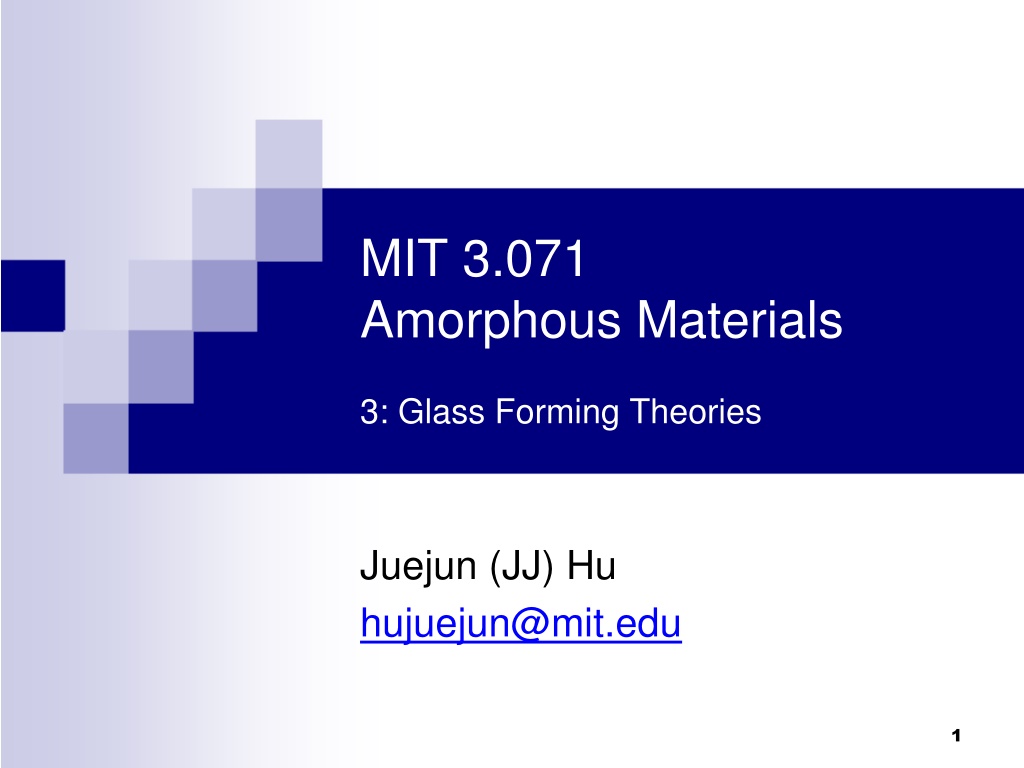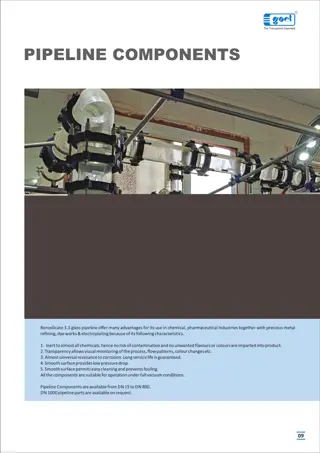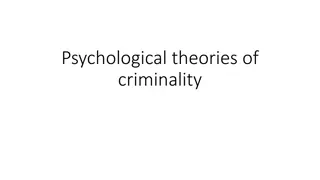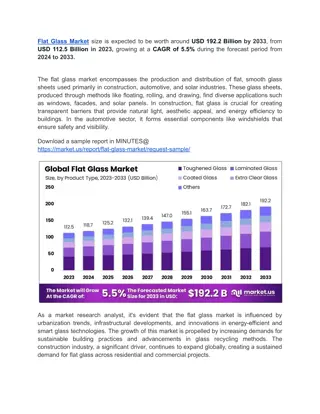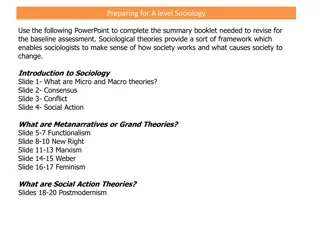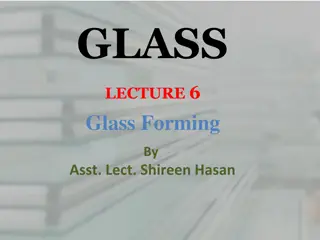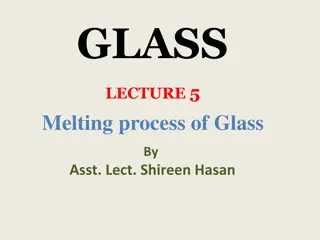MIT 3.071 Amorphous Materials
Dive into the intricate world of glass formation, exploring theories, nucleation kinetics, thermodynamics, and crystallization processes. Discover the factors influencing the transformation from liquid to glassy state, and unravel the fundamentals of inorganic glasses through insightful readings. Gain insights into homogeneous and heterogeneous nucleation, energy barrier contributions, and growth kinetics.
Download Presentation

Please find below an Image/Link to download the presentation.
The content on the website is provided AS IS for your information and personal use only. It may not be sold, licensed, or shared on other websites without obtaining consent from the author.If you encounter any issues during the download, it is possible that the publisher has removed the file from their server.
You are allowed to download the files provided on this website for personal or commercial use, subject to the condition that they are used lawfully. All files are the property of their respective owners.
The content on the website is provided AS IS for your information and personal use only. It may not be sold, licensed, or shared on other websites without obtaining consent from the author.
E N D
Presentation Transcript
MIT 3.071 Amorphous Materials 3: Glass Forming Theories Juejun (JJ) Hu hujuejun@mit.edu 1
After-class reading list Fundamentals of Inorganic Glasses Ch. 3 (except Section 3.1.4 in the 1994 version) Introduction to Glass Science and Technology Ch. 2 3.022 nucleation, precipitation growth and interface kinetics Topological constraint theory M. Thorpe, Continuous deformations in random networks J. Mauro, Topological constraint theory of glass 2
Glass formation from liquid V, H Supercooled liquid Liquid ? Supercooling of liquid and suppression of crystallization ? Glass transition: from supercooled liquid to the glassy state ? Glass forming ability: the structural origin Glass transition Glass Crystal Tf Tm T 3
Glass forming theories The kinetic theory Nucleation and growth All liquids can be vitrified provided that the rate of cooling is fast enough to avoid crystallization. Laboratory glass transition Potential energy landscape Structural theories Zachariasen s rules Topological constraint theory 4
Crystallization is the opposite of glass formation Crystallized Amorphous Suspended Changes in Nature, Popular Science 83 (1913).
Thermodynamics of nucleation G T = = G S G H TS Liquid S S l s G l s G T G T l s Crystal When T < Tm, = = 0 G G G l s s T l ( ) V T S m Driving force for nucleation Tm T 6
Thermodynamics of nucleation G Homogeneous nucleation = G S S Heterogeneous nucleation = + G G G l s S W Size Surface energy contribution = G S S ( ) = Energy barrier for nucleation G V T T S l s m 7
Kinetics of nucleation G Nucleation rate: = G S W k T S exp R D n B E = + G G G = 0exp D D D l s S W k T B Size + E W = 0exp D R D n k T B : , 0 T T W R m n ( ) = G V T T S l s m 0: 0 T R n 8
Kinetics of growth Flux into the nucleus: Nucleus E Atom exp F k T B Flux out of the nucleus: + E G exp F k T B 9
Kinetics of growth Net diffusion flux: Nucleus R F F Atom g E G = 1 exp exp k T k T B B E G ~ exp k T k T B B : 0, 0 T T G R m g 0: 0 T R n 10
Crystal nucleation and growth Metastable zone of supercooling Crystallization Driving force: supercooling Both processes are thermally activated Tm Supercooling 11
Time-temperature-transformation diagram Driving force (supercooling) limited T Diffusion limited Critical cooling rate Rc R. Busch, JOM52, 39-42 (2000) 12
Critical cooling rate and glass formation Critical cooling rate ( C/s) 9 10-6 3 10-3 6 10-3 10 107 1 109 1010 Typical cooling rate ( C/s) 1-10 103 102-104 105-108 Material Technique Silica GeO2 Air quench Liquid quench Droplet spray Melt spinning Selective laser melting Vapor deposition Na2O 2SiO2 Salol Water Vitreloy-1 Typical metal Silver 106-108 Up to 1014 T max~ d : thermal diffusivity Maximum glass sample thickness: R c 13
Glass formation from liquid V, H Supercooled liquid Liquid Increasing cooling rate Glasses obtained at different cooling rates have different structures With infinitely slow cooling, the ideal glass state is obtained 3 2 1 Tm T 14
Potential energy landscape (PEL) The metastable glassy state E Metastable glassy state Thermodynamically stable crystalline state Structure 15
Potential energy landscape (PEL) PE Laboratory glass states Ideal glass Crystal Atomic coordinates r1, r2, r3N 16
Laboratory glass transition Liquid: ergodic Glass Glass: nonergodic, confined to a few local minima t Liquid obs Inter-valley transition time : 1exp B = k T B B : barrier height : attempt frequency 17
Glass former: high valence state, covalent bonding with O Modifier: low valence state, ionic bonding with O Network modifiers Glass formers Intermediates 18
Zachariasens rules Rules for glass formation in an oxide AmOn An oxygen atom is linked to no more than two atoms of A The oxygen coordination around A is small, say 3 or 4 Open structures with covalent bonds Small energy difference between glassy and crystalline states The cation polyhedra share corners, not edges, not faces Maximize structure geometric flexibility At least three corners are shared Formation of 3-D network structures Only applies to most (not all!) oxide glasses Highlights the importance of network topology 19
Classification of glass network topology Floppy / flexible Underconstrained Isostatic Stressed rigid Overconstrained Critically constrained # (constraints) < # (DOF) Low barrier against crystallization # (constraints) = # (DOF) Optimal for glass formation # (constraints) > # (DOF) Crystalline clusters (nuclei) readily form and percolate PE PE PE r1, r2, r3N r1, r2, r3N r1, r2, r3N 20
Number of constraints Denote the atom coordination number as r Bond stretching constraint: / 2 r r Bond bending constraint: r ( 2) 2 3 One bond angle is defined when r = 2 Orientation of each additional bond is specified by two angles Total constraint number: ( r r ) ( = ) 22.5 3 2.5 3 r n 2 r Mean coordination number: r r n = 2 r 2 r 21
Isostatic condition / rigidity percolation threshold Total number of degrees of freedom: Isostatic condition: ( ) 2 3 2.5 3 r n r = 3 rn 2 Phillips' magic coordination number = 2.4 n r 2 r Examples: GexSe1-x AsxS1-x SixO1-x ( ( ( ) ) ) = + = + = + = = = + + + 4 1 2 2 2 r x x x 3 1 2 2 r x x x 4 1 2 2 2 r x x x Why oxides and chalcogenides make good glasses? 22
Temperature-dependent constraints The constraint number should be evaluated at the glass forming temperature (rather than room temperature) Silica glass SixO1-x Bond stretching Normalized distribution 1 3 x = SiO2 r r + Si O n n Si O 2 2 O-Si-O bond angle ( 2 3 Si r ) n Si Isostatic condition Si-O-Si bond angle in silica glass 23
Temperature-dependent constraints Each type of constraint is associated with an onset temperature above which the constraint vanishes Topological constraint theory of glass, ACerS Bull.90, 31-37 (2011) 24
Enumeration of constraint number Bond stretching constraints (coordination number): 8-N rule: applies to most covalently bonded nonmetals (O, S, Se, P, As, Si, etc.) Exceptions: heavy elements (e.g. Te, Sb), boron anomaly Bond bending constraints: Glasses with low forming temperature: = # 2 3 r BB Atomic modeling or experimental characterization required to ascertain the number of active bond bending constraints 25
Property dependence on network rigidity Many glass properties exhibit extrema or kinks at the rigidity percolation threshold r = 2.4 J. Non-Cryst. Sol.185, 289-296 (1995). 26
Measuring glass forming ability = Figure of merit (FOM): Tx : crystallization temperature Tg : glass transition temperature T T T x g CP Tg is dependent on measurement method and thermal history Alternative FOM: ( ) ( x g T T ) T T m x Hruby coefficient T Tg 27
Summary Kinetic theory of glass formation Driving force and energy barrier for nucleation and growth Temperature dependence of nucleation and growth rates T-T-T diagram and critical cooling rate Laboratory glass transition Potential energy landscape Ergodicity breakdown: laboratory glass transition Path dependence of glass structure Glass network topology theories Zachariasen s rules Topological constraint theory Parameters characterizing glass forming ability (GFA) 28
